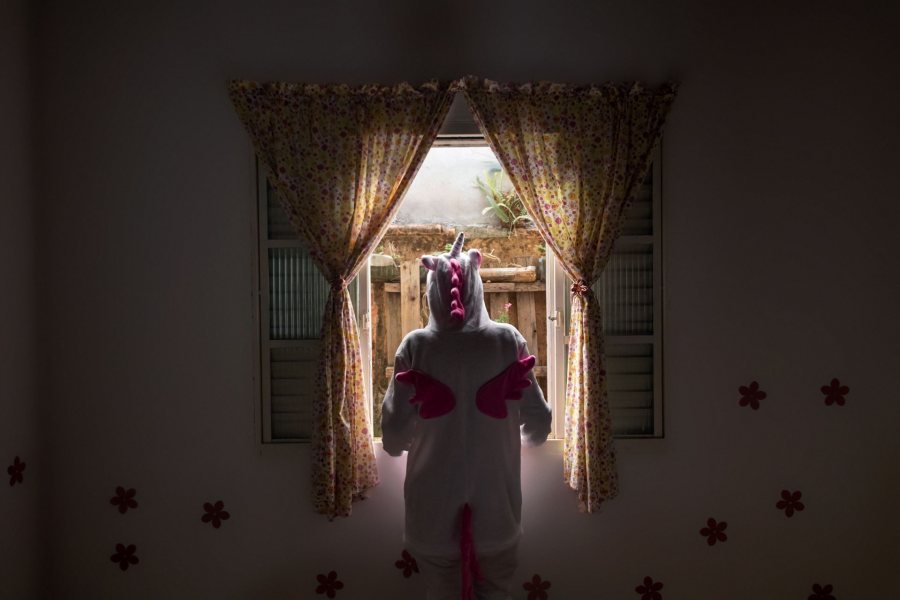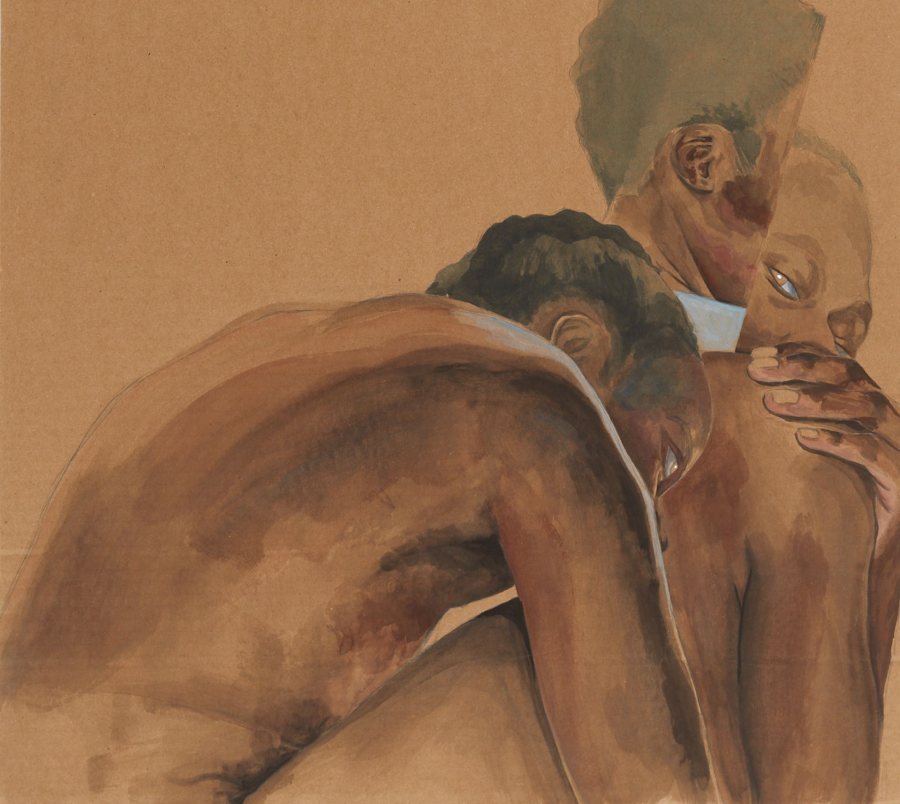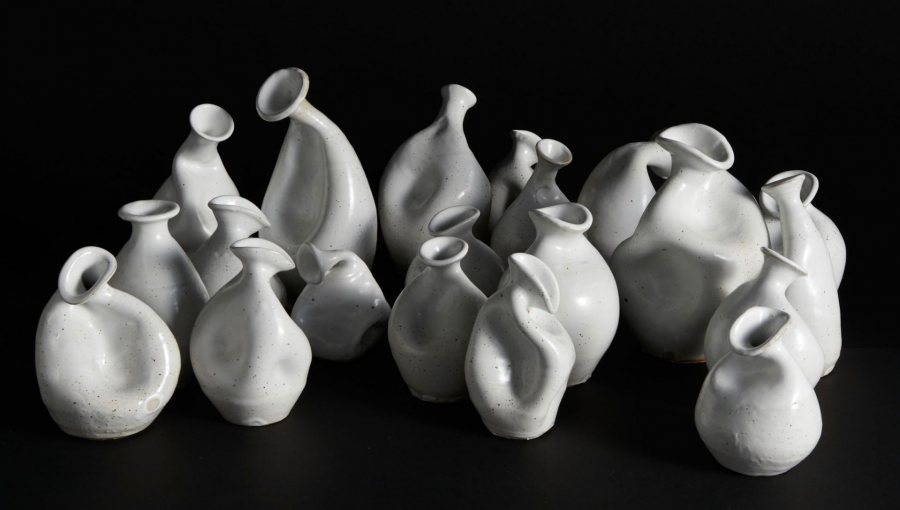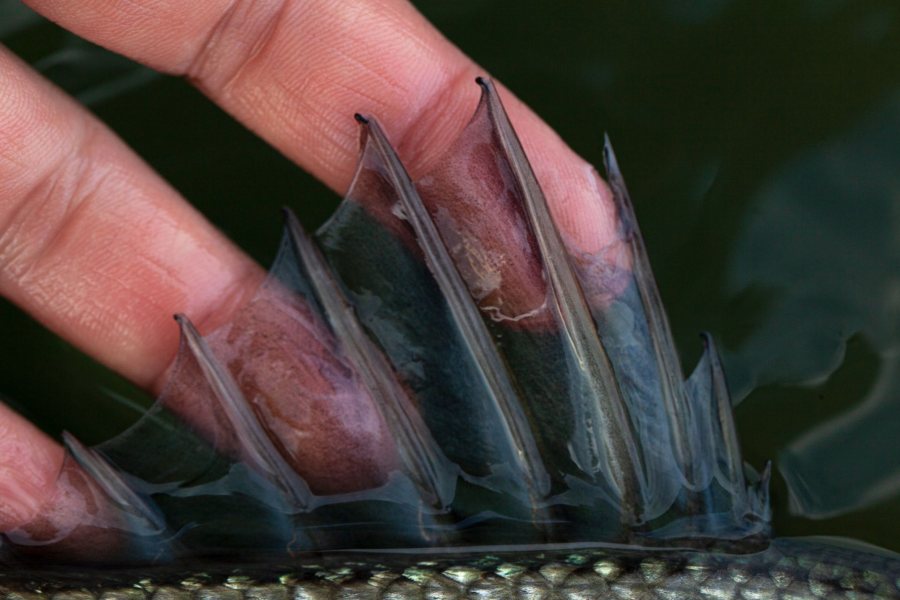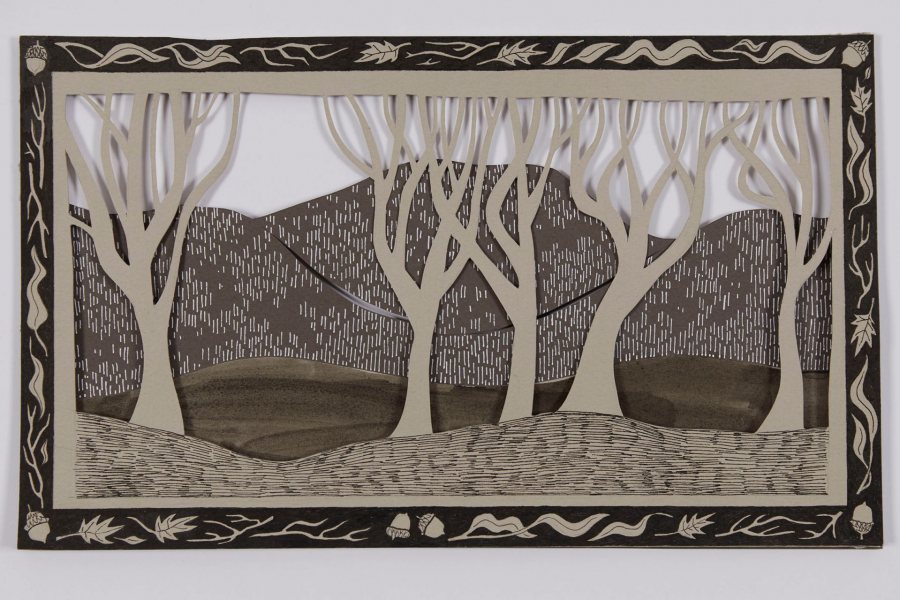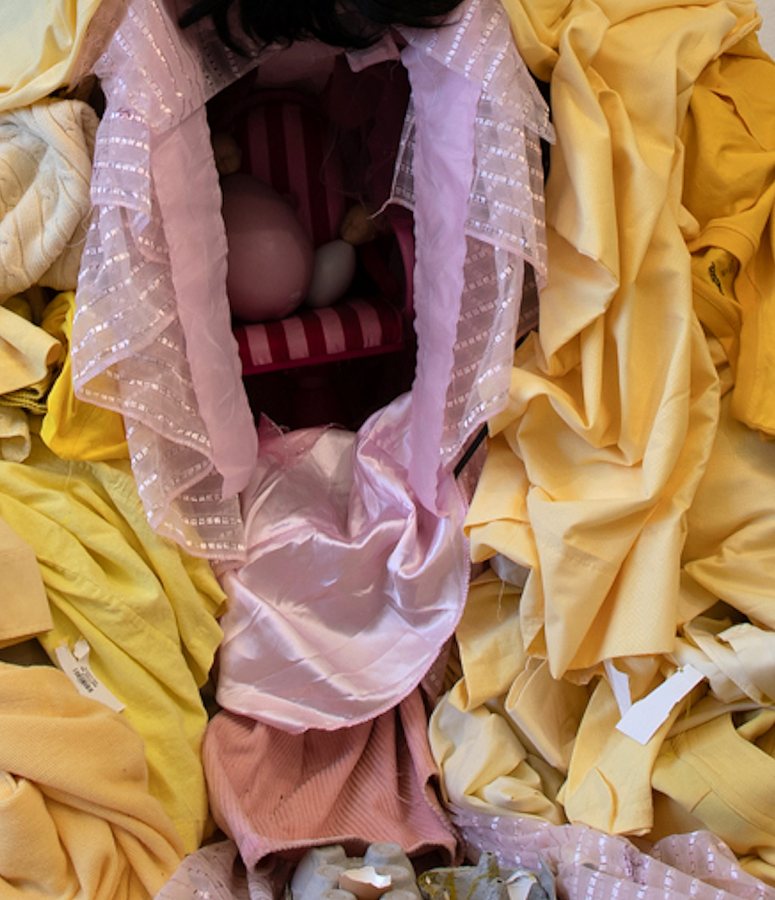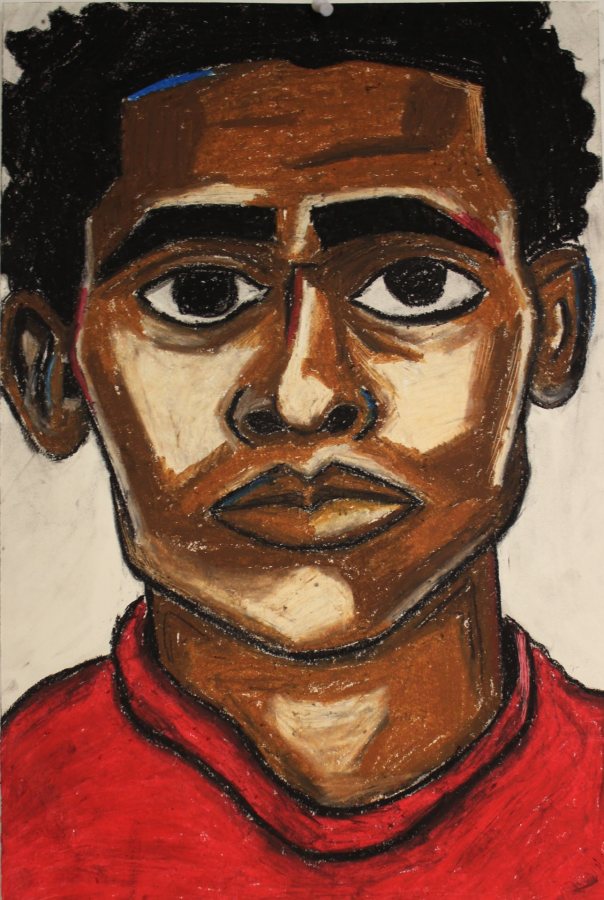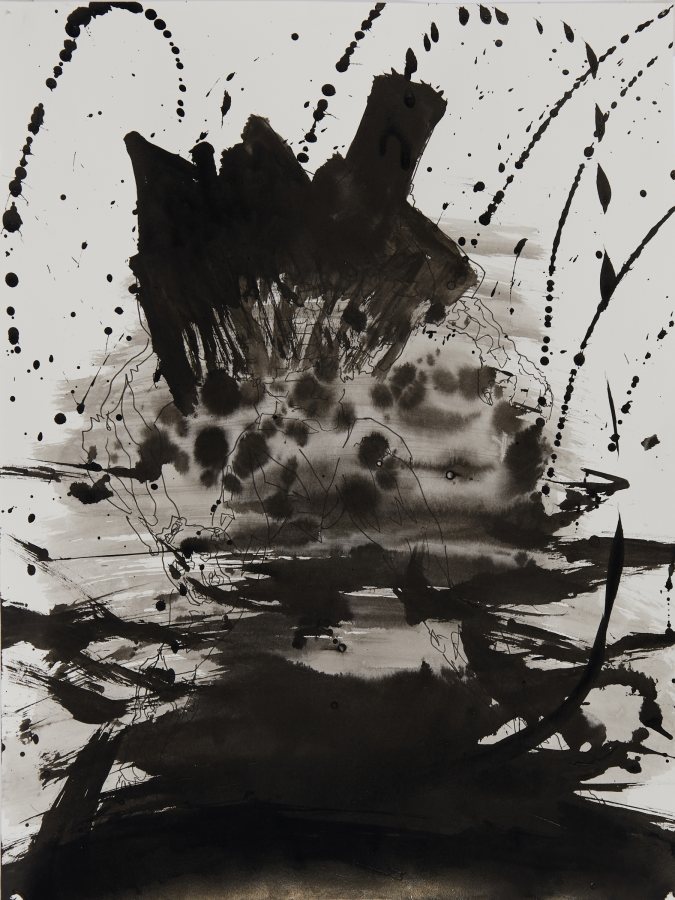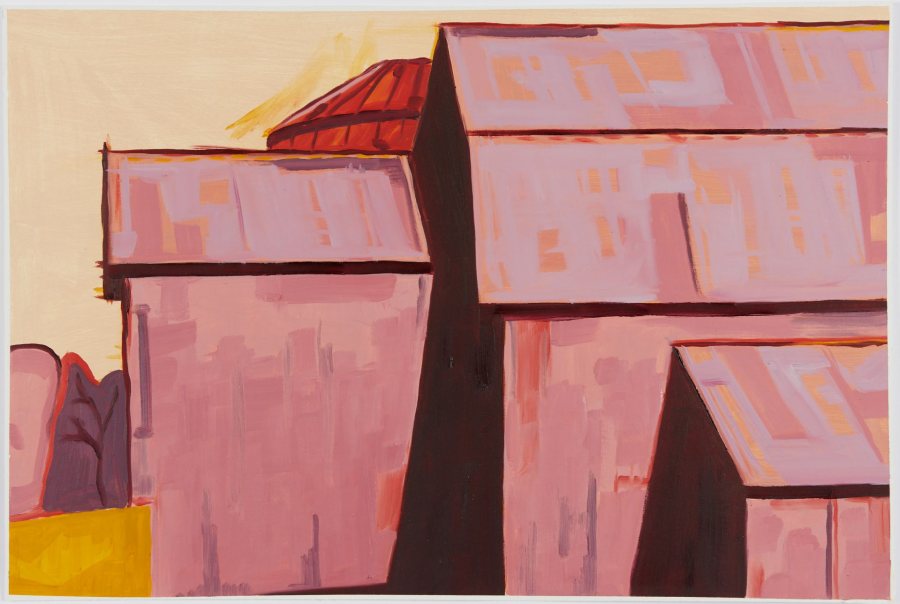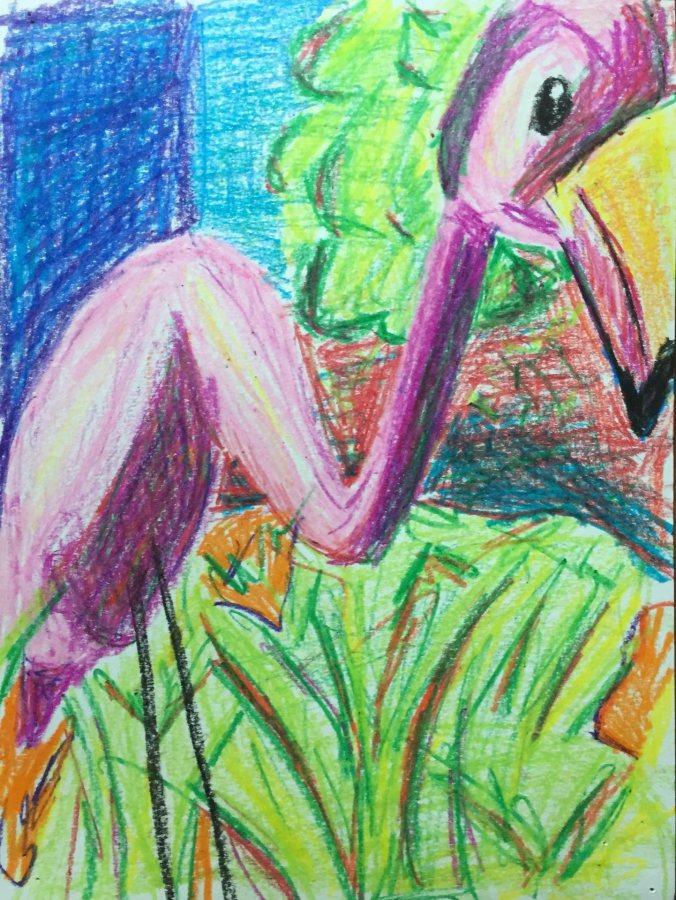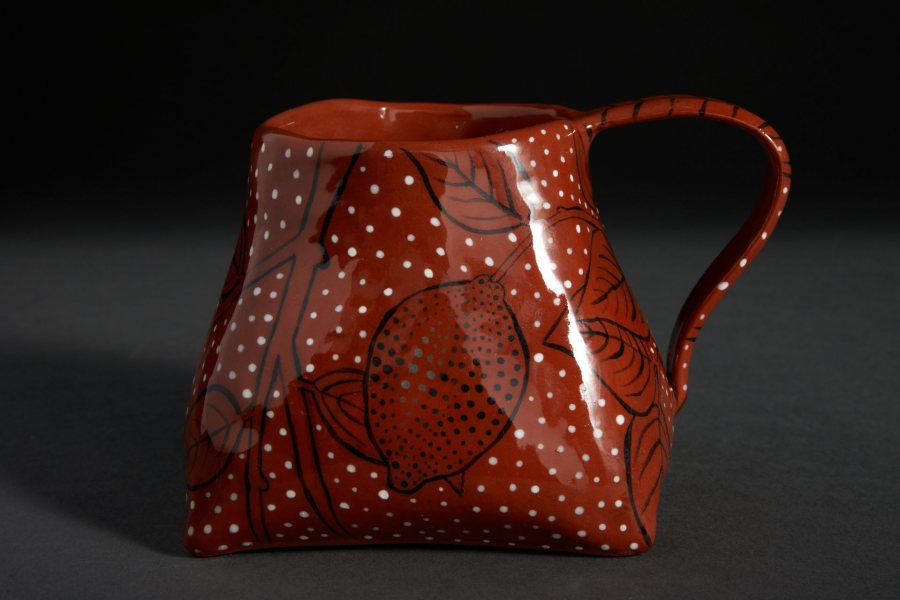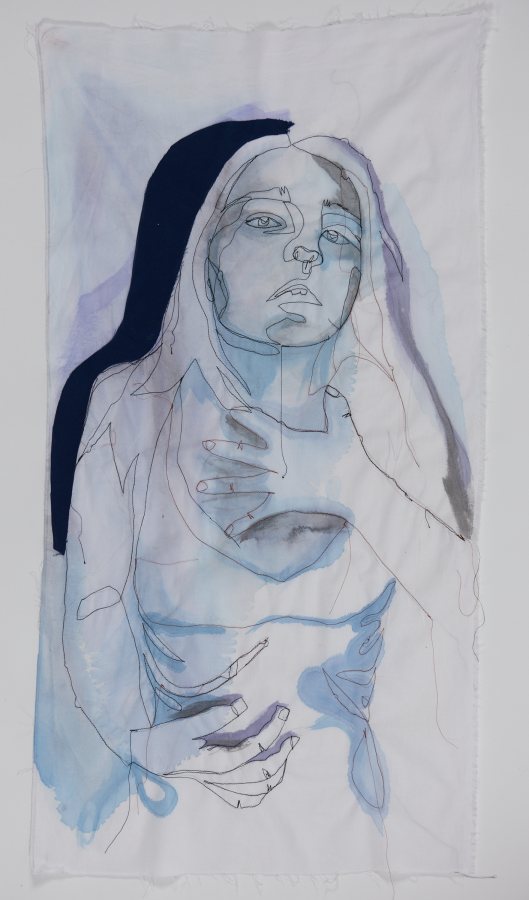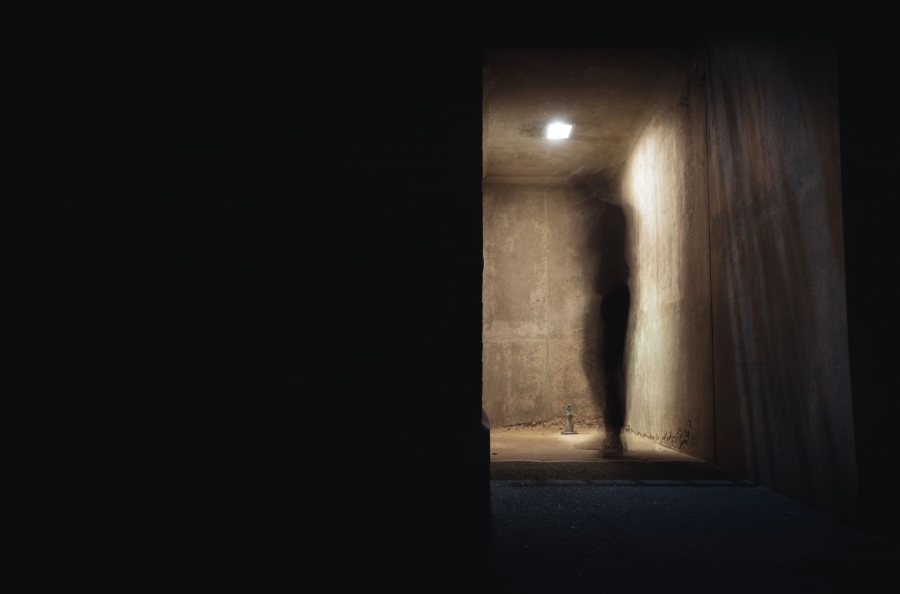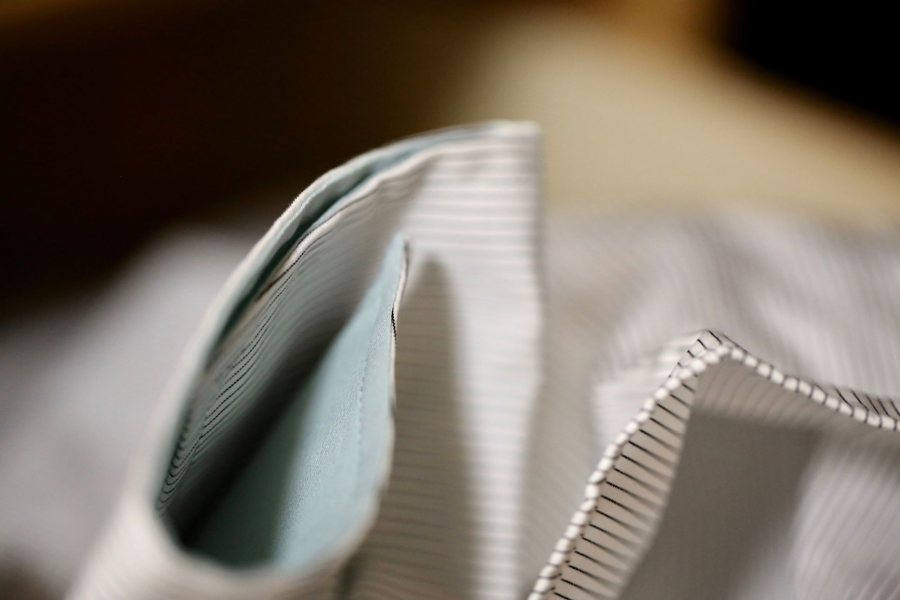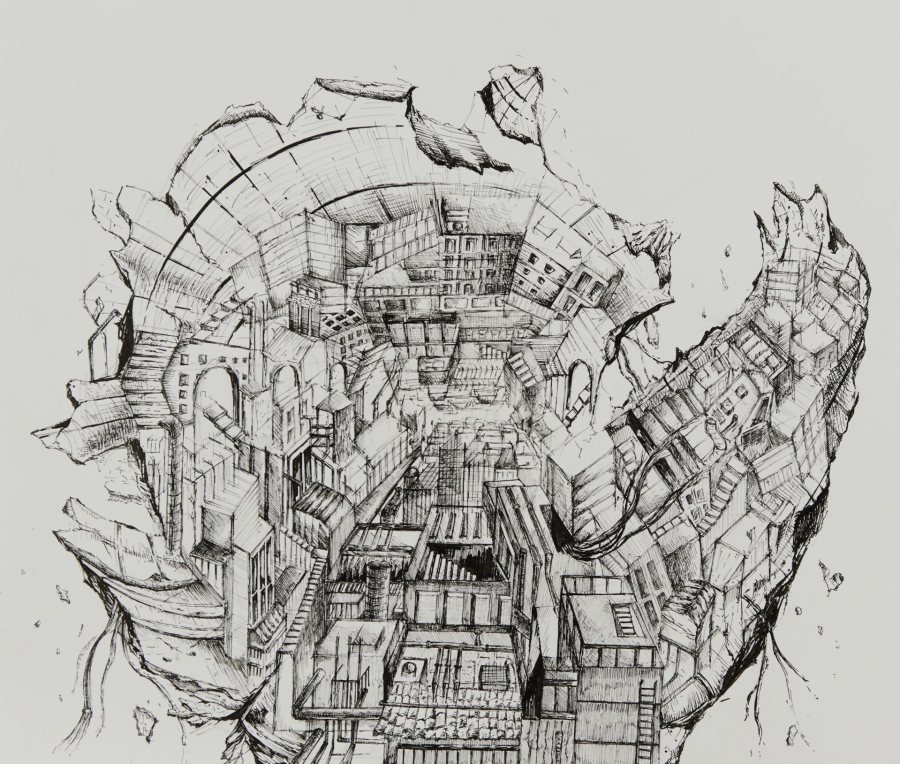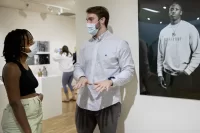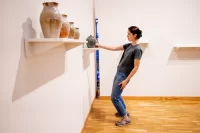
For Pamela Johnson, the associate professor of art and visual culture who has guided 15 senior studio art majors through the second half of this year’s thesis process, the work she’s looking at now has proven prescient.
There are echoes of the comforts of home, which many if not most of the students returned to in March, but also dystopian and imagined worlds, disequilibrium and emotional intensity.
“Given the reality we are now living in, the work that our seniors developed and the vision they offer us is even more essential to protecting and celebrating our humanity,” Johnson says. “We need art now more than ever.”
Bates Communications multimedia producer Theophil Syslo interviews a range of senior artists to hear them reflect on their artwork, and on creating artwork in an unprecedented time.
Each spring, the Senior Thesis Exhibition opens with fanfare and with hundreds of people walking through the physical space of Bates Museum of Art to witness a triumph: the artistic visions of the year’s studio art seniors, now realized through a range of dazzling artwork.
This year, like so many other changes due to the COVID-19 global health crisis, the exhibition is online, featuring images and statements from each senior.
Senior Thesis Exhibition: 5 p.m. Eastern today!
Reflecting and honoring the traditional time of day that a Bates Senior Thesis Exhibition would open, this year’s online exhibition goes live at 5 p.m. Eastern time today, April 24.
That means none of the collective experience of walking through a space together, or the “hugs and laughs and tears” that make the museum come alive with ambitions realized and creativity on physical display, says museum director Dan Mills.
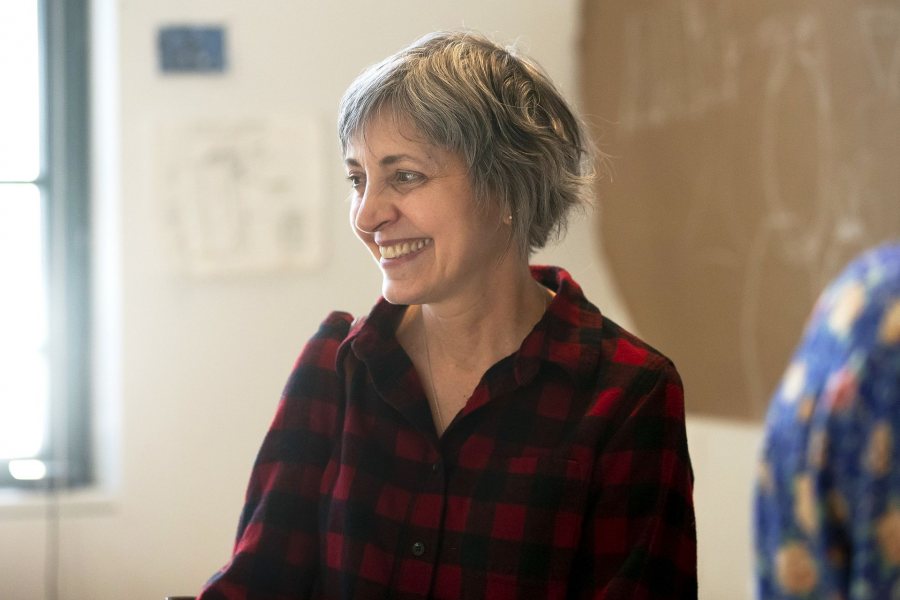
In February, Associate Professor of Art and Visual Culture Pamela Johnson, adviser to the Class of 2020 studio art majors, works with her seniors in an Olin Arts Center studio space. (Phyllis Graber Jensen/Bates College)
But it’s been gratifying for him to be part of the team of faculty and staff that expanded the online presentation this year. “We offer our heartfelt congratulations to these artists, and invite others to carefully view, and reach out and congratulate them as well,” Mills says.
The hope is that, as the online exhibition reaches viewers near and far through social media and other means, gestures of congratulation and support will flow digitally to the 15 seniors.
For Carolina González Valencia, the assistant professor of art and visual culture who guided the seniors during the fall semester, it’s been particularly special to witness the upward trajectory of this group of artists, some of whom were in the first class she taught on arriving at Bates in 2016, “Drawing and Intention.”
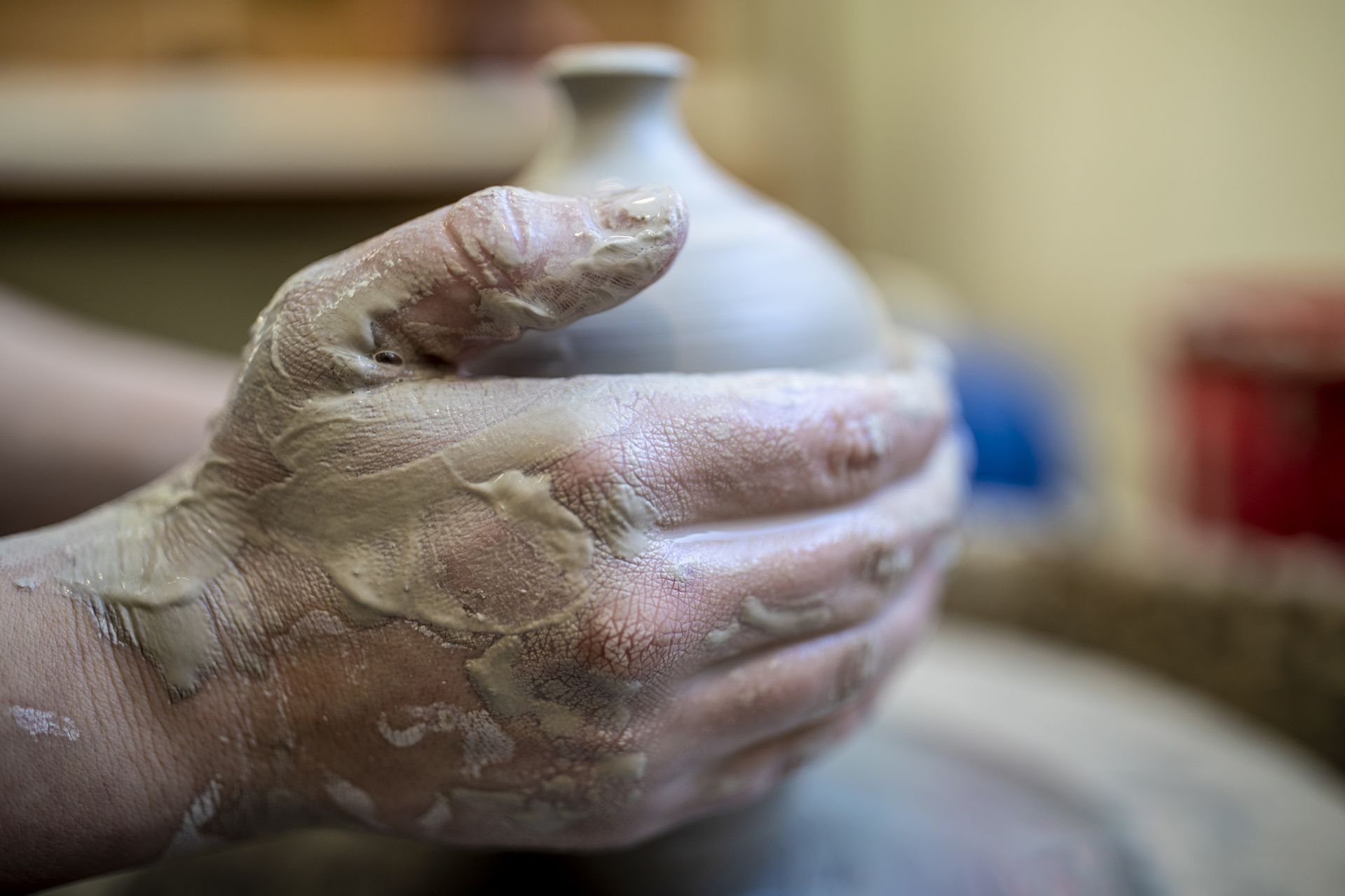
The hands of Celia Feal-Staub ’20 of Putney, Vt., work the potter’s wheel in Olin Arts Center in February. (Phyllis Graber Jensen/Bates College)
She invites the seniors to remember their studios as they were in the first days of classes in 2019, empty and ready for their work.
“Treat the new journeys you will find ahead with the same bravery, excitement, rigor, kindness, and community building as you did while doing these theses,” she says. “Remember, that it is all about practice, and mark by mark you will start to create what leads you ahead.”
Still, what has been undeniably painful is the way this annual process was cut short, Johnson says, when the college quickly moved to remote learning in March.
With little ability to plan, students had to break down their studios and pack up their work, some of it not quite finished, and head home to locations where for many, there could be no dedicated space to create art. (Issues of equity become more readily apparent outside of Olin Arts Center, Johnson noted.)
Some of the seniors’ artwork was damaged in transit. Other pieces had to be left behind altogether.
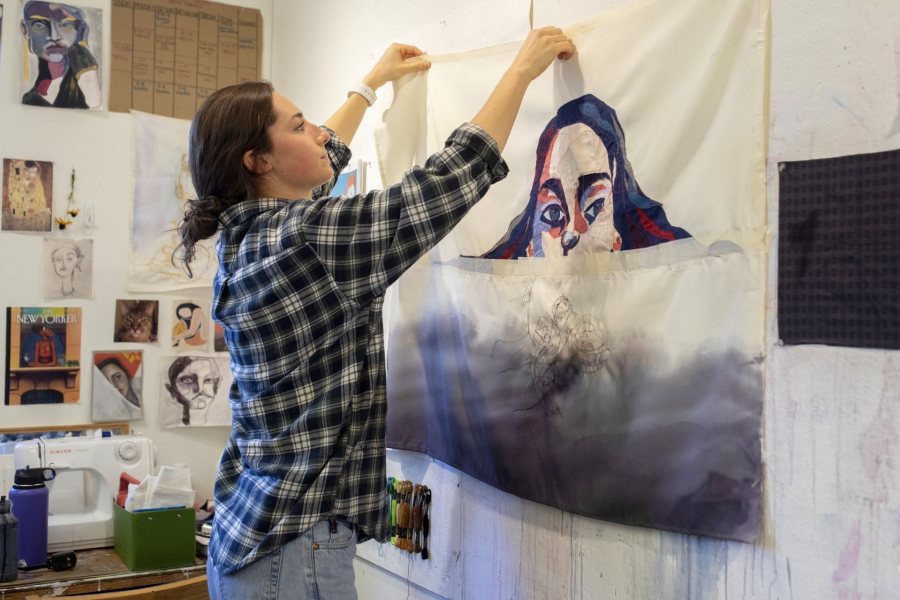
Grace Smith ’20 of Williamstown, Mass., works on artwork in her Olin Arts Center studio space in February. (Phyllis Graber Jensen/Bates College)
As painful as it has been to know that her students — like all seniors — have lost a piece of their senior year, Johnson hopes they hold on to how they persevered in a time of disruption.
“Our arts students will help show us the way forward.”
“Our students in all the arts at Bates are creative and resilient,” Johnson says. “By definition they are great problem solvers. The arts teach you to work devotedly without ever being certain of the outcome.
“Our arts students — our musicians, theater artists, poets, writers, dancers and visual artists — will help show us the way forward, and revive our spirits along the way.”
Ariel Abonizio of Cuiaba, Brazil
“More haunting than ghosts”
“Sometimes, things feel more present when they are gone — a missing family member, an abandoned house, or a single sock without its mate,” says Ariel Abonizio.
Through photographs, videos, and installations, Abonizio attempts to “document what is not there. I make copies of a reality that never truly existed, not even in my dreams — I make unicorns.”
For Abonizio, the things that are not there — such as unicorns — “often resemble apparitions, events from my past that linger on despite not being actually there. When something is forgotten, I can still feel its contours, as something still remains. It is as if silence could be louder than words.”
At other times, the opposite happens. The things that are not there afford a presence that is “unfulfilling and resembles absence. It is like seeing a fake smile or being in a house full of strangers. The moments when presence vanishes and turns to nothing are more haunting than ghosts.”
Mayele Alognon, Louisville, Ky.
“Parts of me are hidden, obscured, or spliced”
“Is there one authentic version of self, or are there multiple — even infinite — versions that are all equally authentic?” asks Mayele Alogon.
Her artwork assumes “that the latter is closer to the truth,” she says. “I am African American. I am female. I am an immigrant. I am a daughter. I am a sister.”
Working from photographs that she takes of herself, Alogon creates nude self-portraits on cardboard, starting with line drawing, then using gouache, an opaque watercolor.
She finds meaning by using items “that are often thrown out without a second thought. The meaning of a painting can change knowing the previous uses of the surface and its near fate as garbage.”
While wholeness is a major theme of her paintings, she presents her body “in fragments. Parts of me are hidden, obscured, or spliced. In some paintings, it may be difficult to tell where one figure begins and where another ends, because with this multifaceted process comes complexity and ambiguity.”
Celia Feal-Staub of Putney, Vt.
“To experiment with form — and also with collapse”
At first, Celia Feal-Staub was enthralled by the usefulness of the clay objects she created — mugs, bowls, pitchers, jars, plates — and the “complete and utter control” that she had over what emerged from the potter’s wheel.
“I controlled the speed of the wheel, and the pressure of my hand which pushed the clay wall out, creating a different curve each time.” But what, she came to wonder, would it feel like to lose control, “to fully experiment with form— and also with collapse?”
She discovered that allowing a loss of control allowed her to open a door. “Rather than barricading emotion out,” she allowed a wider range of feelings to “seep into my work: anxiety and desperation and joy and compassion.”
“With a squeeze of the vessel’s neck, or push to the belly, they take on entirely new forms — perhaps forms of people in love, listening deeply to each other, enveloped in hatred, rejection, longing, acceptance or the lack of it, or empathy.”
Nick Eaton, Lake Oswego, Ore.
“When an effort is made to stop and observe”
Nick Eaton’s digital photographs are creations in more ways than one.
The end product, photographs of striped bass that Eaton caught, is one creation. Another creation are the flies that he hand-ties — using elk and deer hair, rabbit fur, and hen feathers — and uses to catch the fish.
Fishing and photography, he says, have allowed him to “examine my relationship with nature, and the beauty that can be seen when an effort is made to stop and observe.”
He takes his photographs shortly after catching a fish, holding it in the salt water, scales visible to the camera, and keeping its gills submerged to allow the fish to breathe.
“As I stood there in cold, waist-deep water with wet, salty hands trying to get the perfect shot, I admired the sheer magnificence and strength of this fish,” he said. “I work quickly and then release the fish back into the water.”
Fishing and conservationism share a commitment “to ensuring a healthy environment and ecosystem, keeping our rivers running cold, and preserving fish stocks for generations to come.”
Sophie Gerry of Williamstown, Mass.
“My act of remembering”
When Sophie Gerry is working in her Olin Arts Center studio, she’s thinking about home. “How do I perceive, experience, and remember the landscapes I have spent my life in?” she wonders.
Gerry’s artwork is multidimensional, evoking the woods and mountains surrounding her hometown of Williamstown, Mass., where trails sweep through shaded woods and open meadows and cut across hillsides.
“My memory of those places is strong, though the landscape shifts and evolves with each season,” she says. “Similarly, my perceptions flicker and change over time. The art I make is my act of remembering.”
Using pens, pencils, ink washes, and cut-out shapes on papers of various colors, weights, and textures, Gerry places cutout forms on top of and in front of each other, which has led her to creating paper mobiles.
“Layered images and moving mobiles both ask to be looked at from different angles,” she explains, which “begins to capture the visual experience of moving through a natural setting.”
Emma Blaire Hall of Boise, Idaho
“The messiness of the human experience”
Sculptor E.B. Hall is a “mess-maker,” she says.
Collecting “unwanted, rejected, or forgotten items” like plastic toys, articles of clothing, or even dryer lint, she creates abstract pieces that reflect — or challenge — her own experiences.
Hall counts as an influence the multimedia and performance artist Vanessa German, who exhibited at the Museum of Art in 2019–20.
A central piece in Hall’s body of work is an interpretation of the nursery rhyme “Humpty Dumpty.” The massive work incorporates swaths of fabrics, eggshells, dolls, and the limbs of dolls.
“Defining these as lost or found limbs is up to the viewer. Not even the King’s horses or the King’s men can put you back together again,” she says.
“Working with my hands, I am interested in the messiness of the human experience,” she adds. “The themes of my work center around my experiences with the instability in lust, love, death, and life.”
Michael Hogue of Chicago
“See brown and black people for who they are”
Portraits of black and brown faces have often been at best caricature, at worst racist, presenting people “as simple-minded and often subjugated,” says Michael Hogue.
“As a black man, I often feel underrepresented throughout daily life. Because of this I strive to activate and challenge the audience not only to confront the art, but the subject as well.”
In addition to oil, Hogue’s other drawing media includes pencil, colored pencil, charcoal, and marker. “Working within these constrictions gives the portraits a more realistic feel,” he says, citing Terrance Vann and Christopher Clark as inspirations.
Many of his portraits look directly at the viewer. “This is what I want to challenge the audience with,” he says. “This direct gaze inspires me because it is forcing the audience to confront the subject — almost as if it is a mug shot.”
Fredrick Douglass famously challenged the nation by presenting black freedom and dignity in the many photographic portraits that he sat for. Similarly, Hogue hopes “to challenge my audience to see brown and black people for who they are, rather than what people take them for.
Michael Jones of Stratford, Conn.
“Exploring the souls of my creations as real beings”
For his senior thesis, Michael Jones used ink, colored pencils, markers, and white gel pens to create characters in a fantasy world of his creation, Lezeallion.
Inspired by works of epic fantasy such as Brandon Sanderson’s Mistborn series and the Kuroko no Basuke (“Kuroko’s Basketball”) series by Tadatoshi Fujimaki, Jones created “stories of action and power” as well as “magical abilities, dynamic powers, and destructive entities,” he says.
“One of the enjoyments of making my work is creating the visions that I want to see more of in fantasy media and bringing these ideas to life,” Jones says.
“This can include characters with darker skin or anthropomorphic beings interacting in a human setting,” he adds.
“I find satisfaction in exploring the souls of my creations as real beings who face issues that can be metaphorically or literally relatable.”
Otis Klingbeil of Powell, Ohio
“Letting each new piece inform the next”
Painter Otis Klingbeil took his inspiration from Woodstock, Vt., a town that has been important to his family for several generations.
Using “oil, collage, and three-dimensional painting,” he seeks to capture “the essence of this place by simplifying and abstracting rural barns around my town.”
Working from photographs that he took, Klingbeil sometimes makes oil paintings; other times, he works with other materials, cutting them into various shapes and glueing them “at differing heights, building them out…from the front the image is coherent, but it is more fragmented when seen at an angle,” he says.
“I think of my work as a series of repetitive studies of these barns, letting each new piece inform the next,” he adds.
Eden Rickolt of Landenberg, Pa.
“A parody of comfort and happiness”
Real flamingos are few in the U.S., found mostly in southern Florida, explains sculptor Eden Rickolt of Landenberg, Pa. “But plastic, hot pink flamingos are everywhere.”
In her work, Rickolt uses the weirdness and wonder of the ubiquitous plastic flamingo lawn decoration to examine ideas about “iconized American suburbia.”
“My work was initially inspired by the curiosity of what happens when the visually consistent but symbolically erratic object is physically distorted,” she says. “Whereas the ornaments are so utterly uniform and lifeless, my flamingos take on an eerie individualism.”
Rickolt’s sculptures, using a mix of recycled materials, papier-mâché, and fabric, portray “quintessential elements of the American house and yard with the goal of creating new, surreal places that are both funny and disturbing.”
“I like the idea of my sculptures resembling candy that is so sweet that just looking at it will rot your teeth,” she says. “In other words, the colors become a parody of comfort and happiness.”
Madeline Schapiro, Malibu, Calif.
“A garden of permanence”
Working in earthenware, Madeline Schapiro reflects her own history of tending her garden on Saturdays, the red hue of the clay corresponding to the clay she pulled out of the soil in order to plant and nurture seeds. Growing up, Schapiro grew tomatoes, peaches, and lemons, along with vegetables and produce.
But where those gardens came and went with the seasons, Schapiro aims, through her work, to make this clay lasting. With the same hands that weeded and planted, she rolls red clay, rakes it and then folds and drapes it into shape.
“My work is a garden of permanence,” she says. Her inspirations include William Morris’s botanical patterns and 19th century botanical drawings.
Grace Smith of Williamstown, Mass.
“A record of our experiences, pain, battles, and torments”
Smith paints, draws in pencil, sews, and does both embroidery and appliqué on fabric to create her expressive portraits. The mix of mediums is fitting for what she’s trying to translate, the complexity and layering of emotions.
“Most of my portraits move between multiple feelings simultaneously,” she says, which can arrive, “all at once and often confused.”
Smith’s artistic inspirations include Orly Cogan, Egon Schiele, and Gustave Klimt, the latter two known for their portraits of women, often twisted into the frame and bound by rich patterns.
There’s also family heritage in the work of this Williamstown, Mass., native, with fabrics she received from her grandmother woven into the work. “Each holds a story,” Smith says. Those stories include the generations of her family who sat in furniture that was once wrapped in these upholstery fabrics.
The process of creating these portraits has been therapeutic, Smith says. It’s taught her to embrace scars, understand pain and look at how bodies convey emotion through movement and posture. “Our bodies are a record of our experiences, pain, battles, and torments,” Smith says.
Jeffrey Spellman of West Roxbury, Mass.
“Preconceived ideas are always incorrect”
In his still photography, Jeffrey Spellman seeks to examine the space between the familiar and the blurred.
He works with a deliberately slow shutter speed, contrary to much of portraiture today, with its emphasis on detail. He asks his subjects to move within the space he’s chosen, enjoying the unpredictability of what comes next.
“No two shots are ever the same and all of my preconceived ideas about what the shot will be are always incorrect,” says Spellman.
His thesis project also includes a video that depicts the harsh realities of mass shootings by describing what to do if caught in such a situation.
“The video is purposefully devoid of human life,” Spellman says. He uses a robotic voice to give the instructions, a voice that is meant to reflect “the robotic response triggered by mass shootings in this country.”
The camera becomes a character in this video, and once again, motion is the focus of Spellman’s process.
Haiyao Tian of Beijing
“Intimate, emotional, and meditative”
When Haiyao Tian left Beijing to come to Bates four years ago, she brought just two suitcases with her, filled with items that weren’t necessarily practical.
There were favorite books and pictures stuffed into them, and other “useless” objects. She has no regrets. “It was the personal treasures I cherished that helped me recreate a home away from home.”
Those objects are a key part of her thesis project, which she describes as a visual diary of her room at Bates, photographed day after day in multiple sorts of light and in varying circumstances (playing 70s rock while she’s shooting the photographs might bring a different level of energy to the image, for instance).
“I want to push the boundaries of my imagination to make works that go beyond a simple documentation of personal objects, and instead are intimate, emotional, and meditative,” Tian says.
Tian uses wide-angle lenses and plays with shallow depth of field to create ambiguity and depth, paying homage to the work of artists like Sally Mann and Todd Hido.
But these images of her belongings, photographed in her “sanctuary from the outside world,” speak directly to the life she has built for herself. “To some extent, I would say this project is a personal portrait of myself,” she says.
Philip Wu, New Taipei City, Taiwan
“Defy the norm and provoke confusion”
Philip Wu occasionally leaves lines unconnected in his pen and ink cityscapes, aiming, he says, to better evoke the fictional characteristic of dystopia. He keeps much of his work deliberately monochromatic, hoping to transcend the boundaries of time.
“While most of my work remains conceptual in nature,” he says. “Each work is conceived by integrating reflections of reality with fictional elements to construct a dystopian image.”
Wu says he grew up being reminded that the privileges he was given should not be taken for granted, and his thesis work reflects the “experiences and devastations I have been fortunate enough to avoid suffering.”
But it also reflects hope, a “happy ground” he believes could be found. His approach is to illustrate his perspective on dystopian cities, with “a twist reflecting possibilities that human actions can incur on the environment.”
To build his versions of dystopian cityscapes, Wu relied on photographs he took in various countries, from their slums to their skyscrapers. His interest in architecture and space can be glimpsed throughout his thesis work. His goals are to “defy the norm and provoke confusion.”
